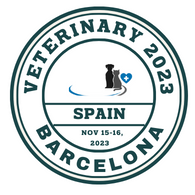Sessions & Tracks
Track 1: Veterinary and Animal Science
Veterinary and Animal Science contributes to human welfare by detecting and containing zoonotic diseases. Security is provided, and in a roundabout manner through applications to people resulting from fundamentally curative research. Through domesticated animal welfare monitoring and treatment, as well as by keeping pets healthy and long-lived, they also contribute to maintaining the food supply. Depending on the sort of study, veterinary researchers frequently collaborate with experts in disease transmission and other health or general researchers. Veterinarians are typically morally obligated to be concerned about animal welfare. Veterinary and Animal Science play a vital role in the well-being of animals and the health of our planet. This multidisciplinary field encompasses a wide range of topics and areas of study, each contributing to the understanding, care, and conservation of animals. Here's a brief overview of key content areas within Veterinary and Animal Science: Veterinary Medicine: Veterinary professionals diagnose, treat, and prevent diseases in animals, ensuring their health and well-being. They are crucial in providing medical care to pets, livestock, and even wildlife. Animal Nutrition: The study of dietary requirements for animals is essential for their growth, health, and productivity. Nutritionists develop balanced diets tailored to the specific needs of various species.
Track 2: Animal Welfare
Animal Welfare science makes use of a variety of indicators, including as life duration, disease, immunosuppression, behavior, physiology, and reproduction, while there is disagreement over which of these markers provides the most useful data. Cover for animal welfare is frequently based on the assumption that non-human animals are aware of the considerations that must be made in order for them to prosper or endure, especially when they are in human care. Animal protection the welfare of animals is what makes beings happy. The standards for exceptional animal welfare vary greatly depending on the context. These standards are always being reviewed, debated, and reexamined by animal welfare organizations, lawmakers, and academics around the world. Animal welfare is a fundamental concern that encompasses the ethical and humane treatment of animals in various contexts, including farming, research, entertainment, and domestic settings. Promoting animal welfare is not only a moral imperative but also essential for the well-being of animals and the health of ecosystems. Here's a brief overview of content related to animal welfare: Definition of Animal Welfare: Explain what animal welfare means and why it's important. Emphasize the ethical, scientific, and legal aspects of animal welfare. The Five Freedoms: Introduce the Five Freedoms framework, which outlines key principles for ensuring animal welfare. Discuss freedom from hunger and thirst, discomfort, pain, injury, and disease, fear and distress, and the freedom to express normal behavior.
Track 3: Animal Vaccines
Animal Vaccines are a key tool to prevent disease burden in domestic animals, pets, farm animal to maintain animal health and welfare. Vaccination plays a vital role in control and prevention of diseases. The Animal vaccines available today represent years of innovative research and meet many of the disease threats faced by pets and farm animals. Vaccines are available for many animals, dogs (canine parvovirus), sheep’s or cattle (bluetongue), travelling pets (rabies). The task in developing new vaccines tells us that vaccines are part of many of animal medicines – that together protect and treat our companion and farm animals. Animal vaccines are a crucial aspect of veterinary medicine and animal health. They play a pivotal role in preventing the spread of diseases, reducing suffering among animals, and ensuring the safety of food products of animal origin. Here's a comprehensive overview of animal vaccines: Introduction to Animal Vaccines: Animal vaccines are biologically engineered substances designed to stimulate the immune system of animals, thereby providing protection against specific diseases. These vaccines are developed to mimic natural infections without causing illness. Importance of Animal Vaccines: Disease Prevention: Vaccines are the most effective way to prevent the spread of contagious diseases among animals. They reduce the risk of epidemics and pandemics in animal populations. Economic Impact: Vaccination can have a significant positive economic impact by reducing the cost of treating sick animals, increasing productivity in agriculture, and protecting animal-based industries.
Track 4: Animal Reproduction
The continued life of an animal group depends on reproduction in large part. Animals compete with other people to maintain their own level of activity for as long as necessary in order to enable them to produce tissue that is essential to the survival of their species. The reproductive tissue usually ends up being clearly isolated from the individual to form the border of an independent organism. Animal hereditary traits help advance breeding innovation and testing services, such as genetic trait tests, DNA splicing, and hereditary disease diagnostics.
Animal hereditary traits have recently experienced tremendous growth, which is primarily attributable to growing demand for animal products because of the expanding global population, the development of cutting-edge technologies in animal , testing, and growing public awareness of veterinary hereditary issues. The market for animal is segmented based on testing providers, products, and regions. The Asian market is expected to demonstrate a significantly swift development during the indicator period, heavily influenced by the growing demand for veterinary finish items, use of animal welfare acts, and increase in the number of inhabitants in domesticated animals. Created terrains like Europe and North America are likely to grow at nearly higher CAGR than the Asian market.
Track 5: Animal Dermatology
There’s much more to veterinary dermatology than addressing a rogue rash or two. The skin diseases animals experience vary significantly by species, so veterinary dermatologists need to have experience in many different types of treatments. They also receive training in internal medicine, immunology, and allergy since some dermatological issues stem from a health problem within. Animal dermatology is a specialized branch of veterinary medicine that focuses on the diagnosis and treatment of skin, hair, nail, and ear disorders in animals. Just like in humans, skin conditions in animals can be quite diverse and range from common issues like allergies to more complex dermatological diseases. Here's a comprehensive overview of animal dermatology: The Importance of Animal Dermatology, Healthy skin and coat are essential for an animal's overall well-being. Skin serves as a protective barrier, regulates body temperature, and plays a crucial role in sensory perception. Dermatological issues can cause discomfort, pain, and even affect an animal's quality of life.
Track 6: Emergency and Critical Care
When animals become injured or suddenly develop a life-threatening health problem, they need prompt medical attention. Veterinary specialists in emergency and critical care are trained for these types of high-pressure situations. No matter the emergency, they’re equipped to act swiftly and ensure the animal in question gets the immediate attention it needs. Emergency and Critical Care (ECC) in veterinary medicine is a specialized field dedicated to the immediate assessment, diagnosis, and treatment of animals facing life-threatening medical conditions. ECC veterinarians and their teams play a crucial role in saving lives and providing intensive care to animals in distress. Here's a comprehensive overview of Emergency and Critical Care in veterinary medicine: The Importance of Emergency and Critical Care: ECC is vital for managing severe injuries, illnesses, and medical emergencies in animals. Just as in human medicine, prompt and effective ECC can be the difference between life and death for animals.
Track 7: Internal Medicine
Internal Medicine or Internists specialists, apply knowledge and clinical expertise to the diagnosis and treatment of various conditions affecting vital organs, including diseases of the respiratory system, digestive system, liver and pancreas, endocrine system, urinary system, and immune system as well as infectious diseases, among many others. Internal medicine veterinarians can further specialize in the following:
• Cardiology
• Large animal internal medicine
• Neurology
• Oncology
• Small animal internal medicine
Internal Medicine in veterinary practice refers to the specialized field that deals with diagnosing and treating complex medical conditions affecting animals. Veterinarians who specialize in internal medicine, known as veterinary internists, undergo extensive training to address a wide range of diseases and disorders that can affect an animal's internal organs, systems, and overall health. Here's a comprehensive overview of Internal Medicine in veterinary practice: The Role of Veterinary Internists: Veterinary internists are specialists who provide in-depth medical expertise and advanced diagnostics for animals with complex or chronic health issues. They focus on diseases of internal organs, metabolic disorders, infectious diseases, and immune-related conditions.
Track 8: Animal Microbiology
Animal Microbiology is the field which deals with the study of different types of diseases which is caused by microorganisms like virus, fungi, bacteria etc in the animals. It is important to maintain the microbial safety in the animals which provides food, meat, milk, dairy products which is used by human’s food in the day to day life. Microorganisms might lead to disease companionship between animals and humans.
Veterinary microbiologists are often the driving force behind developing treatments for infectious animal diseases. They typically work in a lab setting to research bacteria, parasites, and other microorganisms that cause disease. Because some diseases can affect both animals and humans, veterinary microbiologists play a crucial role in protecting public health.
-
Fungal diseases
-
Viral diseases
-
Bacterial infection
-
Other microbial infections
Animal microbiology is a specialized field of study within microbiology that focuses on understanding the microbial communities associated with animals. Microbes, including bacteria, viruses, fungi, and other microorganisms, play significant roles in the health, disease, and overall well-being of animals. Here is an overview of animal microbiology:
The Importance of Animal Microbiology:
Health and Disease: Microbes can both promote health and cause diseases in animals. Understanding the interactions between animals and their microbial communities is essential for maintaining animal health and preventing diseases. Nutrient Absorption: Many animals rely on microbial symbionts in their digestive tracts to help break down complex carbohydrates and other nutrients, making them more accessible for absorption. Immune System Development: Exposure to certain microbes is critical for the development and proper functioning of an animal's immune system.
Track 9: Anesthesia and Analgesia
In veterinary management of animals, anaesthesia (rendering animals unconscious to permit procedures) and analgesia (reducing the pain an animal is suffering) have vital importance in improving animal welfare, as well as permitting the ongoing developments in medical and surgical advances. Anaesthesia has always carried risks, and we have an increasing availability of monitoring equipment to help us monitor the physiological function of the body during anaesthesia with the aim of reducing morbidity and mortality in our animals.
Anesthesia and Analgesia in veterinary medicine are critical components of providing safe and pain-free medical care to animals. These practices involve the careful administration of drugs and techniques to ensure that animals are pain-free and comfortable during surgeries, procedures, and recovery. Here is a comprehensive overview of Anesthesia and Analgesia in veterinary medicine:
The Importance of Anesthesia and Analgesia:
Pain Management: Anesthesia and analgesia aim to alleviate pain and discomfort in animals, improving their overall well-being and recovery. Surgical Procedures: Anesthesia allows veterinarians to perform surgeries and procedures without causing distress or pain to the animal. Reducing Stress: Anesthesia reduces an animal's stress response during medical interventions, promoting a more positive experience. Diagnostic Imaging: Anesthesia may be necessary for animals undergoing diagnostic procedures like MRIs or CT scans.
Track 10: Clinical Pharmacology
Veterinary Clinical Pharmacology is the study of drug administration and drug effects in animals, many of which are sick or injured. For example, if it is known that drug elimination is decreased by renal failure, then the dose of that drug must be reduced for an animal with renal failure. Veterinary Clinical Pharmacologists help ensure animals receive safe, effective treatment. Clinical pharmacology is a vital discipline within the field of medicine that focuses on understanding how drugs interact with the human body and how to use this knowledge to improve patient care. It encompasses a wide range of activities related to the development, testing, and safe and effective use of medications. Here is an overview of clinical pharmacology:
Key Functions of Clinical Pharmacology:
Drug Development: Clinical pharmacologists play a critical role in the development of new drugs, from the initial stages of discovery through preclinical testing to clinical trials involving human subjects. They help identify potential drug candidates and assess their safety and efficacy. Dosing and Administration: Determining the right dose and route of administration for a drug is essential to achieve the desired therapeutic effect while minimizing side effects. Clinical pharmacologists provide guidance on dosing regimens tailored to individual patients. Drug Interactions: Medications can interact with each other or with other substances, affecting their efficacy and safety. Clinical pharmacologists assess potential drug-drug and drug-food interactions to prevent adverse effects.
Track 11: Human-Animal Bond
The Human-Animal Bond is a mutually beneficial and dynamic relationship between people and animals that is influenced by behaviors essential to the health and wellbeing of both. This includes, among other things, emotional, psychological, and physical interactions of people, animals, and the environment. The veterinarian's role in the Human-Animal Bond is to maximize the potentials of this relationship between people and animals. The human-animal bond is a profound and mutually beneficial connection that exists between humans and animals. This bond is characterized by emotional, physical, and even therapeutic interactions that enhance the well-being of both parties. Here is an in-depth exploration of the human-animal bond:
Historical Significance:
The human-animal bond has deep historical roots. From early domestication for work and protection to the development of companionship and assistance animals, humans and animals have shared a unique relationship throughout history.
Emotional Benefits:
Companionship: Animals provide companionship and emotional support. Their presence can alleviate feelings of loneliness and isolation, particularly in individuals living alone. Stress Reduction: Interacting with animals, such as petting a dog or cat, has been shown to reduce stress levels and release feel-good hormones like oxytocin and endorphins.
Track 12: Veterinary Dentistry
Veterinary Dentistry is the field of dentistry applied to the care of animals. It is the art and science of prevention, diagnosis, and treatment of conditions, diseases, and disorders of the oral cavity, the maxillofacial region, and its associated structures as it relates to animals. Animals might not care if they have aesthetically pleasing teeth, but healthy chompers are essential for their daily lives. Dental problems can lead to malnourishment and general discomfort.
Veterinary dentistry is a specialized branch of veterinary medicine that focuses on the oral health and dental care of animals. Just like humans, animals can suffer from a variety of dental issues that can affect their overall health and quality of life. Here's an in-depth look at veterinary dentistry:
Importance of Veterinary Dentistry:
Oral Health: Dental problems can cause pain, discomfort, and difficulty in eating for animals. Proper dental care is essential for their well-being.
Overall Health: Dental issues in animals can lead to more serious health problems, such as heart, liver, and kidney disease. Regular dental care can help prevent these complications.
Common Dental Problems in Animals:
Periodontal Disease: This is the most common dental issue in animals. It involves inflammation of the gums and can lead to tooth loss if left untreated. Tooth Decay: Animals can develop cavities, particularly in their molars. Broken or Fractured Teeth: Accidents or chewing on hard objects can lead to broken or fractured teeth.
Track 13: Animal Physiology
Veterinary Care and management are usually led by a veterinary physician (usually called a veterinarian, veterinary surgeon or "vet" - doctor of veterinary medicine or veterinary medical doctor). This role is the equivalent of a physician or surgeon (medical doctor) in human medicine, and involves postgraduate study and qualification.
In many countries, the local nomenclature for a vet is a protected term, meaning that people without the prerequisite qualifications and/or registration are not able to use the title, and in many cases, the activities that may be undertaken by a vet (such as animal treatment or surgery) are restricted only to those people who are registered as vet. For instance, in the United Kingdom, as in other jurisdictions, animal treatment may be performed only by registered vets (with a few designated exceptions, such as Para veterinary workers), calling oneself a vet without being registered or performing any treatment is illegal.
Track 14: Behavioral Medicine
Behavioral Medicine is concerned with the integration of knowledge in the biological, behavioral, psychological, and social sciences relevant to health and illness. These sciences include epidemiology, anthropology, sociology, psychology, physiology, pharmacology, nutrition, neuroanatomical, endocrinology, and immunology. The term is often used interchangeably, but incorrectly, with health psychology.[citation needed] The practice of behavioral medicine encompasses health psychology, but also includes applied psychophysiological therapies such as biofeedback, hypnosis, and bio-behavioral therapy of physical disorders, aspects of occupational therapy, rehabilitation medicine, and physiatrist, as well as preventive medicine. In contrast, health psychology represents a stronger emphasis specifically on psychology's role in both behavioral medicine and behavioral health.
Track 15: Wildlife and Ecosystem Health
Wildlife Ecology is the applied ecology and management of wild populations of birds and mammals. This includes the study of terrestrial and aquatic wildlife & biodiversity monitoring and conservation, endangered species management, protected areas planning, ornithology, stream ecology, and fish habitat. Wildlife and ecosystem health are intricately linked aspects of our natural world. The health of wildlife populations directly impacts the health and balance of ecosystems, and vice versa. Here's an in-depth exploration of wildlife and ecosystem health:
Interconnectedness of Wildlife and Ecosystems:
Biodiversity: Wildlife represents a diverse array of species that play unique roles within ecosystems. Biodiversity is a measure of ecosystem health and resilience. Ecosystem Services: Healthy ecosystems provide critical services like pollination, water purification, and pest control, which are essential for both wildlife and human well-being. Food Web: Wildlife species are part of complex food webs, and changes in one population can ripple through the ecosystem, affecting other species.
Track 16: Veterinary Parasitology
Veterinary Parasitology is the study of animal parasites, especially relationships between parasites and animal hosts. Parasites of domestic animals, (livestock and pet animals), as well as wildlife animals are considered. Using a variety of research methods, they diagnose, treat, and prevent animal parasitizes. Medical Parasitology is the branch of sciences dealing with parasites which infect humans, the diseases caused by them, clinical picture and the response produced by humans against them. It is also concerned with various methods of their diagnosis, treatment and their prevention & control. Veterinary parasitology is a specialized field within veterinary medicine that focuses on the study of parasites that affect animals. These parasites can range from microscopic organisms to larger worms and insects, and they can cause a variety of health issues in animals. Here is an overview of veterinary parasitology:
Types of Animal Parasites:
Internal Parasites: These parasites live inside the host animal. Common examples include roundworms, tapeworms, and flukes. External Parasites: External parasites live on or in the host's skin and include fleas, ticks, mites, and lice. Protozoa: Single-celled organisms like coccidia and Giardia can cause diseases in animals.
Track 17: Zoonotic & Infectious Diseases
A Zoonosis is an infectious disease that has jumped from a non-human animal to humans. Zoonotic pathogens may be bacterial, viral or parasitic, or may involve unconventional agents and can spread to humans through direct contact or through food, water or the environment. They represent a major public health problem around the world due to our close relationship with animals in agriculture, as companions and in the natural environment. Zoonoses can also cause disruptions in the production and trade of animal products for food and other uses.
Zoonotic and infectious diseases are a significant concern for both animal and human health. These diseases are caused by pathogens that can be transmitted between animals and humans. Understanding and managing these diseases are crucial to preventing outbreaks and protecting public health. Here is an overview of zoonotic and infectious diseases: Zoonotic Diseases: These are diseases that can be transmitted from animals to humans. Examples include rabies, Lyme disease, and avian influenza (bird flu). Infectious Diseases: These are caused by pathogens such as bacteria, viruses, fungi, and parasites. They can be contagious among both animals and humans. Examples include COVID-19, HIV/AIDS, and tuberculosis.
Track 18: Environmental Threats
One major area of environmental impact that comes with the operation of a veterinary establishment is the consumption of resources. Much like human hospitals, veterinary establishments are resource intense. You need medicine, equipment, fluids, inhalant gases, temperature regulated environments and much, much more. Environmental threats refer to factors or phenomena that endanger the health and stability of the natural environment, which, in turn, can have adverse effects on ecosystems, biodiversity, and human well-being. These threats often result from human activities and can lead to long-term ecological and societal consequences. Here are some major environmental threats: Global Warming-The rise in average global temperatures due to the increased concentration of greenhouse gases like carbon dioxide in the atmosphere. Extreme Weather: Climate change leads to more frequent and severe weather events such as hurricanes, droughts, and heatwaves.
Track 19: Animal Structure & Function
Animal Structure and Function is a lecture and laboratory-based subject that explores the amazing morphological diversity of life and how this has evolved to meet essential biological functions. The course is structured around a series of key ‘biological challenges’ within which we will compare and contrast different ‘biological solutions’ to the same problem across animals ranging from corals through to apes. In the practical’s, you will learn how to classify animals and interpret their features, and develop an integrated understanding of animal diversity and the evolutionary forces that drive this. Animal structure and function refer to the anatomy and physiology of animals, encompassing their physical characteristics and biological processes that enable them to survive and thrive in their respective environments. This fundamental knowledge is essential for understanding how animals interact with their surroundings and each other. Here's an overview:
Anatomy and Structure:
Skeletal System: The skeleton provides structural support, protects internal organs, and facilitates movement. It can vary greatly among species, from exoskeletons in insects to endoskeletons in vertebrates. Muscular System: Muscles are responsible for movement by contracting and relaxing. The type and arrangement of muscles differ according to an animal's mobility and lifestyle. Circulatory System: This system includes the heart and blood vessels that transport oxygen, nutrients, and waste products throughout the body. It is crucial for metabolism and homeostasis.
Track 20: Small Animal Medicine and Surgery
The Department of Small Animal Medicine and Surgery is dedicated to enhancing the science and practice of companion animal medicine through the teaching and mentoring of students, interns, and residents; by providing exceptional clinical services as part of the College’s Veterinary Teaching Hospital; and through advancing the knowledge of health and disease. Small animal medicine and surgery are integral components of veterinary medicine, focusing on the diagnosis, treatment, and surgical interventions for companion animals, primarily dogs and cats. These disciplines encompass a wide range of medical conditions and surgical procedures designed to improve the health and well-being of pets. Here's an overview:
Small Animal Medicine:
Preventive Care: Routine examinations, vaccinations, and parasite control are essential for maintaining a pet's health. Early disease detection and preventive measures are key components of small animal medicine. Internal Medicine: Small animal internists diagnose and treat a variety of medical conditions, including gastrointestinal disorders, respiratory diseases, endocrine disorders (e.g., diabetes, thyroid issues), and cardiovascular problems.
Track 21: Veterinary and Social Science Research
Veterinarians working in research use a full range of sophisticated laboratory equipment. Veterinarians can contribute to human as well as to animal health. A number of veterinarians work with physicians and scientists as they research ways to prevent and treat various human health problems. Veterinarians help prevent, diagnose and treat health problems in a wide variety of animals. Regardless of whether the animal is a family pet, a prize-winning race horse, a dairy cow, a circus lion, or seal in a zoo, its healthcare depends on veterinarians. Veterinary and social science research is an interdisciplinary field that explores the complex interactions between animals, humans, and society. It combines veterinary medicine with social science methodologies to address a wide range of issues related to animal health, welfare, and the human-animal bond. Here's an overview:
Research Areas: Animal Welfare-Investigating the physical and psychological well-being of animals, including farm animals, pets, and wildlife, to improve their quality of life. Human-Animal Interactions: Studying the relationships between humans and animals, including the emotional, behavioral, and therapeutic aspects of these interactions. One Health: Exploring the interconnectedness of human, animal, and environmental health to address zoonotic diseases, food safety, and global health challenges.
Track 22: Veterinary Telemedicine
Telemedicine is a subcategory of telehealth that involves use of a tool to exchange medical information electronically from one site to another to improve a patient's clinical health status. Examples include using Skype or a mobile app to communicate with a client and visually observe the patient for a post-operative follow-up examination and discussion. Telemedicine is a tool of practice, not a separate discipline within the profession. The appropriate application of telemedicine can enhance animal care by facilitating communication, diagnostics, treatments, client education, scheduling, and other tasks. Practitioners must comply with laws and regulations in the state in which they are licensed to practice veterinary medicine. Telemedicine may only be conducted within an existing veterinarian-client-patient relationship, with the exception for advice given in an emergency care situation until a patient can be seen by or transported to a veterinarian.
Track 23: Animal Genetics
Animal Genetics is the study of genes. Genes impact the performances of an animal and are passed on from parents to offspring. At Hendrix Genetics, we study animals and collect data on the performances or so-called traits they express. Like being resilient to fight off diseases, or being able to grow with fewer resources, and much, much more. We use the latest technology to gather and process these data, and we do so for each and every individual animal in our breeding program. Like that, we are able to carefully evaluate the genetic potential of single animals and select which are the best parents to produce healthier and more efficient offspring. The result is; better breeding today, for a brighter life tomorrow. Animal genetics is a field of biology that focuses on the study of genes and heredity in animals. It involves understanding the genetic makeup of animal species, how traits are inherited, and the genetic factors that influence various aspects of animal biology, including health, behavior, and physical characteristics. Here are key aspects of animal genetics: Animal genetics investigates how traits are passed from one generation to the next through the transmission of genetic information in the form of DNA. It explores the principles of Mendelian genetics, including dominant and recessive alleles, as well as complex inheritance patterns.
Track 24: Layer Poultry Farming
Layer poultry farming means raising egg-laying poultry birds for commercial egg production. Layer chickens are a particular species of hens which need to be raised from one day old, and they start laying eggs commercially from 18-19 weeks of age. They remain to lay eggs continuously till 72-78 weeks of age.
Disease in Layer Poultry Farming
-
Fowl Pox.
-
Newcastle Disease.
-
Infectious Bronchitis.
-
Avian Influenza.
-
Infectious Laryngotracheitis.
-
Mycoplasma synoviae.
-
Aspergillosis.
-
Marek's Disease.
Layer poultry farming is a specialized branch of poultry farming focused on raising hens primarily for the production of eggs. This type of farming involves the careful management of layers to ensure optimal egg production, health, and well-being. Here are key aspects of layer poultry farming: Selection of Layer Breeds-Farmers choose specific layer breeds known for their high egg-laying potential. Common breeds include White Leghorn, Rhode Island Red, Sussex, and Plymouth Rock. Housing and Infrastructure-Layer hens require well-ventilated and comfortable housing with proper nesting boxes and perches. The housing should protect the birds from extreme weather conditions and predators.























